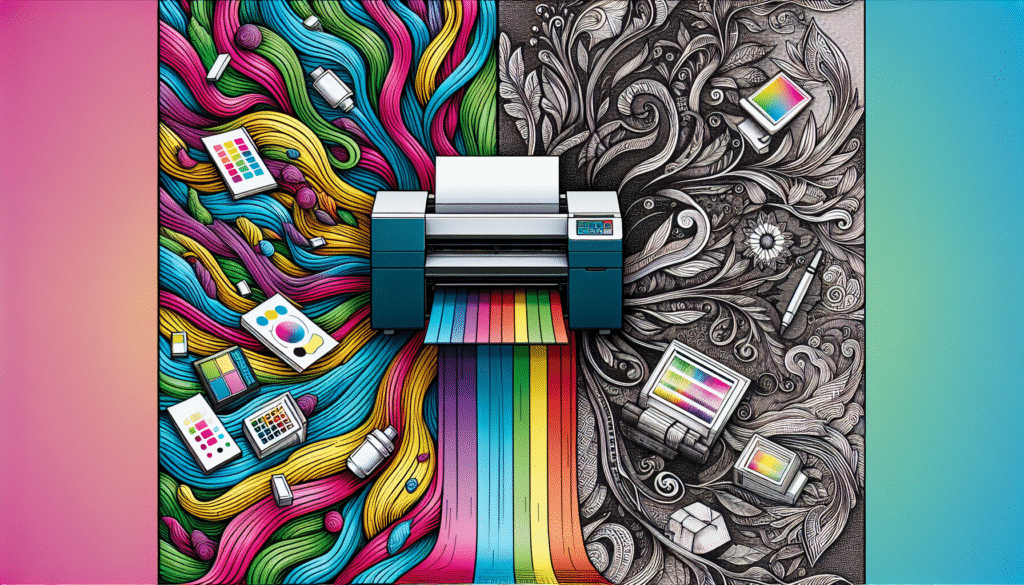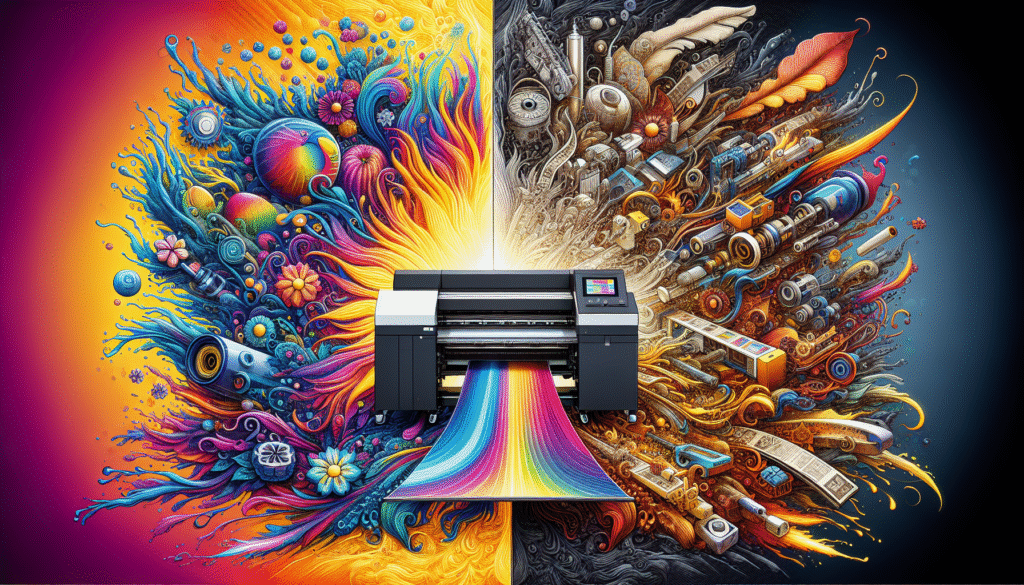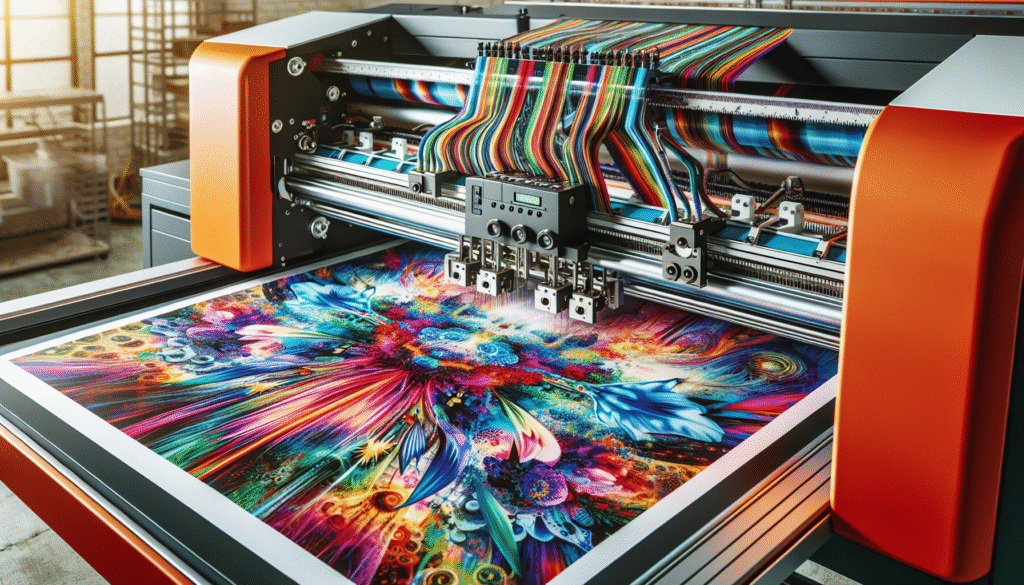Have you ever found yourself standing in a sea of curious eyes, surrounded by questions regarding the details of printing technologies like a curious creature in a bustling marketplace? The realm of digital printing is a vibrant one—filled with options and hidden gems. Today, let’s navigate this creative chaos together as we tackle a much-debated topic: which should we choose, a Sublimation Printer or a Direct to Film (DTF) Printer?

What is Sublimation Printing?
Sublimation printing is like the magic trick of the textile world. It works by turning solid dye directly into gas without passing through the liquid phase—a process that feels like it’s straight from the pages of a fantasy novel. Once this gaseous dye penetrates the fabric, it cools and re-solidifies, creating vibrant, durable images that do not fade away easily.
Pros of Sublimation Printing
When we talk about sublimation printing, we’re diving into a treasure chest filled with enticing benefits:
- Vibrant Colors: The process embeds dye into the substrate, resulting in vivid colors that are sharp and long-lasting.
- Durability: The prints are less likely to fade, crack, or peel over time.
- Soft Finish: Because the ink becomes part of the fabric, the finish is smooth and doesn’t add any texture you can feel.
- Environmentally Friendly: With no need for beyond-dye, leftover waste is minimal, which is always a good thing for our lovely Earth.
Cons of Sublimation Printing
But, like the hero of our favorite story, sublimation is not without its kryptonite. There are some challenges that come along for the ride:
- Fabric Limitations: It works best on polyester or polymer-coated substrates, reducing versatility.
- High Initial Investment: The cost of entry—equipment and compatible materials—can be quite high.
- Color Matching: Achieving the exact shade of color consistently can sometimes require a bit of finesse.
What is Direct to Film (DTF) Printing?
Now, picture a fresh alternative on the horizon: Direct to Film (DTF) Printing, the innovative sibling to traditional methods. In DTF printing, designs are printed onto a special film with a specially formulated ink. Afterward, this film is transferred onto the target medium using heat.
Pros of DTF Printing
Our encounter with DTF printing reveals some appealing advantages as well:
- Versatility: DTF can transfer images onto a wider range of fabrics and surfaces, from cotton to polyester and more.
- Less Prep Time: Compared to screen printing, DTF requires less initial setup and preparation.
- Bright White Inks: Produces vibrant results on both light and dark fabrics, thanks to the use of white ink.
- Low Waste: The precision of DTF means we utilize only the necessary materials for each print.
Cons of DTF Printing
No journey is without its bumps, and DTF printing certainly has its own:
- Learning Curve: Achieving the perfect transfer requires mastering specific techniques.
- Printing Speed: It may be slower than other methods, meaning we need patience when printing large batches.
- Initial Equipment Cost: Like sublimation, setting up a DTF system can be pricey, though costs vary.
Cost Analysis: Sublimation vs. DTF
Now let’s step into the accountant’s room and have a good chat about numbers! Investing in printing equipment is similar to baking a complex multi-layered cake; it requires understanding the ingredients and expected outcomes. Here’s a quick overview in the form of a friendly table:
| Aspect | Sublimation Printing | DTF Printing |
|---|---|---|
| Initial Equipment Cost | Moderate to High | Moderate to High |
| Printing Cost per Item | Lower (for polyester items) | Variable (depends on material) |
| Maintenance | Regular care and specific cleaning | Regular cleaning and maintenance |
| Time Required | Shorter for polyester | Longer for non-polyester materials |

Application Versatility
Imagine a canvas where we can creatively express endless possibilities. In the realm where ingenuity meets practicality, flexibility becomes paramount:
Sublimation Printing Applications
Sublimation printing is like a specialized tailor in many ways. Its strengths shine brightly in particular scenarios:
- Polyester Apparel: Best for sportswear, where vivid colors and durable prints are a must.
- Promotional Products: Mugs, mouse pads, and keychains.
- Home Decor: Think custom throw pillows and vibrant wall art.
DTF Printing Applications
DTF printing reveals its prowess in versatility, akin to a Swiss Army Knife of the printing world:
- Multifabric Apparel: Uniforms, streetwear, and fashion pieces across different materials.
- Decorative Items: Bags, backpacks, and even custom footwear.
- Personalized Merchandise: T-shirts, hats, and hoodies with intricate designs.
Which Is Easier to Use?
Learning how to utilize these printers is like embarking on a journey to become the master chef in a kitchen brimming with delightful aromas. Let’s dissect this regarding ease of use:
Ease of Sublimation Printing
Sublimation printing is relatively user-friendly once the initial setup is complete. The process of transferring prints is straightforward, and with some practice, becomes a second nature.
Ease of DTF Printing
Similar to crafting intricate origami, DTF printing can initially feel complex. However, with persistence, it becomes manageable—especially when transitioning between different types of materials.
Production Speed: Who Wins the Race?
Imagine a thrilling race track—speed becomes crucial when considering print jobs or large orders.
- Sublimation Printing Speed: Once familiar with the process, sublimation allows for quick and efficient production.
- DTF Printing Speed: Slightly slower, especially on larger orders, due to the intricacies of the transfer and adherence.
Maintenance: Longevity in Printing
Like maintaining a cherished bicycle, keeping printers in tip-top shape ensures longer life and smoother operation.
Sublimation Printer Maintenance
Regular checks for clogs in print heads and ensuring ink supply and temperature settings are optimal is key to smooth sublimation printing.
DTF Printer Maintenance
DFT printers require regular inspection of their print heads and heat transfer mechanisms to keep the operation seamless and free from issues.
The Environmental Impact
Our beloved Earth is like a gigantic tapestry, with each of us contributing a thread. Let’s consider the environmental angles of our printing methods:
- Sublimation Printing: Generally generates less waste due to its precise dye consumption.
- DTF Printing: Similarly maintains low waste levels, but requires careful selection of eco-friendly materials to ensure sustainability.
Conclusion: Which to Choose?
Choosing between sublimation and DTF printing is akin to selecting the perfect edible delight from a dessert table—each option offers an alluring taste with unique flavor profiles. As avid explorers of the world of printing, our choice hinges on our specific needs, budgets, and end goals.
If we lean towards vibrant designs on polyester-based products and have the freedom to invest in upfront costs, the sublimation printer is our perfect ally. On the other hand, if our creative journey is focused on broad versatility across multiple materials and designs, DTF printing opens a door to unlimited possibilities.
No matter our decision, both sublimation and DTF printing offer pathways to beautiful, lasting designs that captivate and inspire. Let’s embrace the joy of printing and the unique stories each method helps us weave into our fabrics, one brilliant color at a time.

